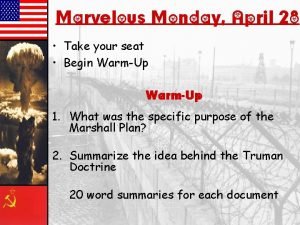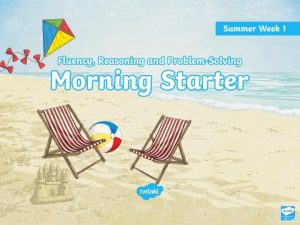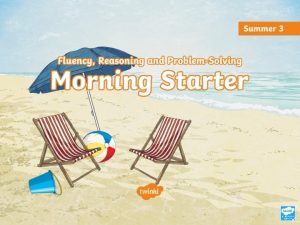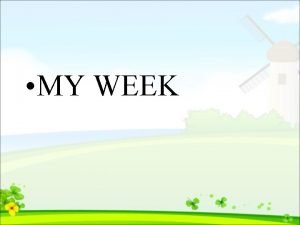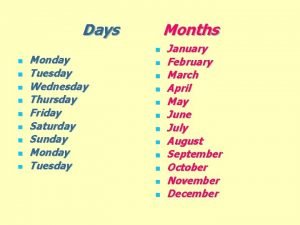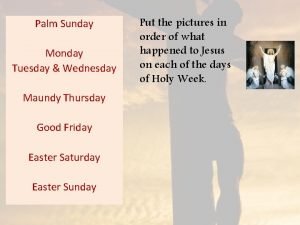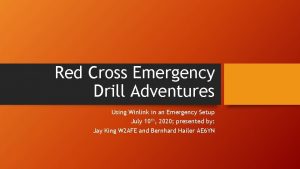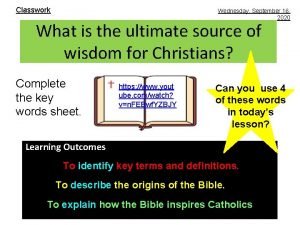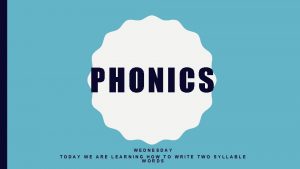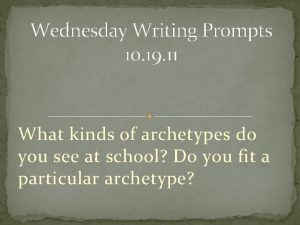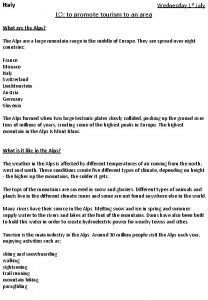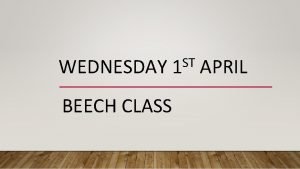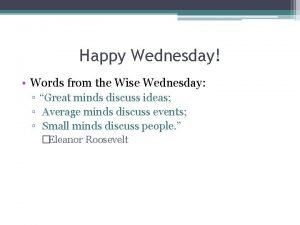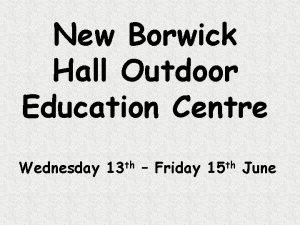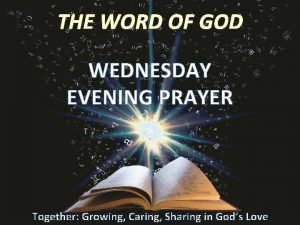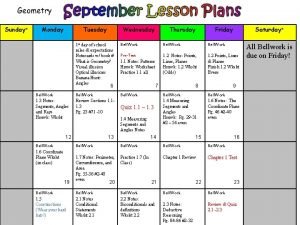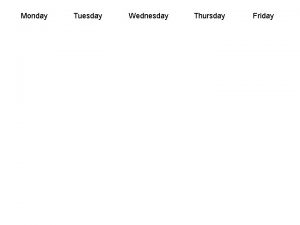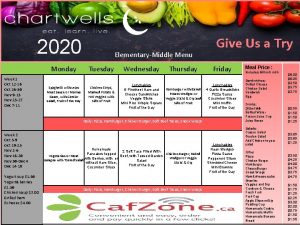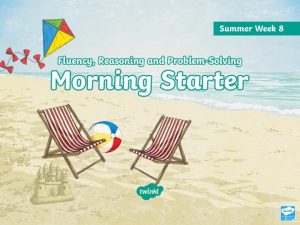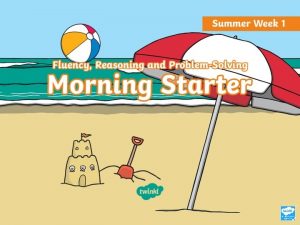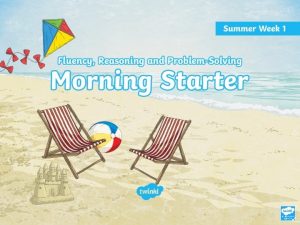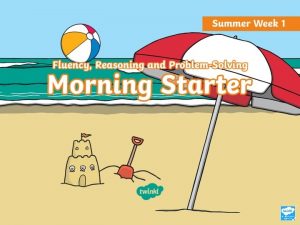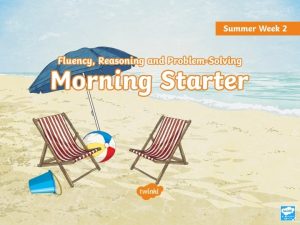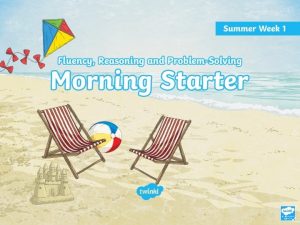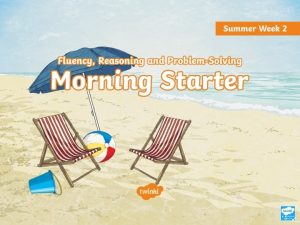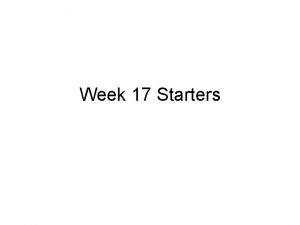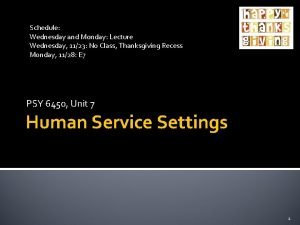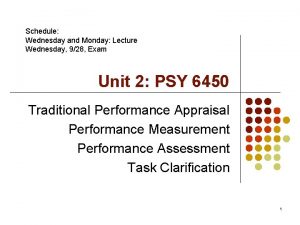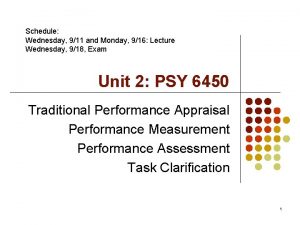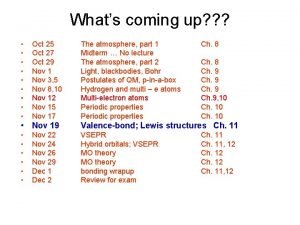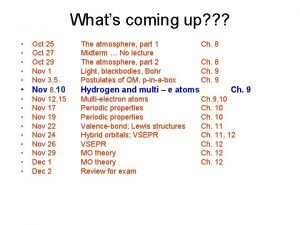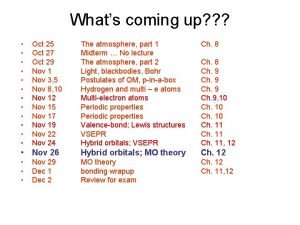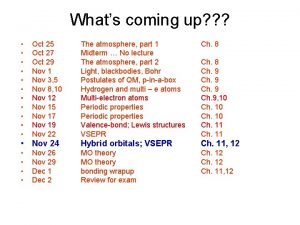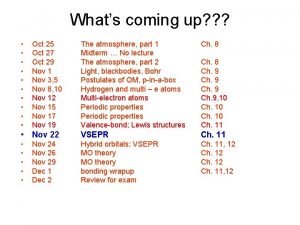Week Oct 5 9 Monday Oct 5 Wednesday























- Slides: 23

Week Oct 5 -9

Monday, Oct 5 Wednesday, Oct 7

Good Morning! 1. Unpack your bookbag. 2. Put your folder in the basket on my desk. 3. Get your pencil bucket and book bin. 4. Read a book and get ready for your day.

Grammar Time!

Testing Procedures (POV Test) 1. Make sure your name is on your paper. 2. Read carefully. 3. Answer the questions carefully. 4. Keep your eyes on YOUR paper! 5. Turn in your work when you are finished.

Activator This week we are learning about text features in nonfiction text. https: //www. youtube. com/ watch? v=-ykw. XZQ 629 s

Learning Objective 8. 1 - I can explain how the author uses words and phrases to inform, explain, or describe. Let's practice this together…

Concept / Skill Development - I do 8. 1 - I can explain how the author uses words and phrases to inform, explain, or describe. Nonfiction texts look very different than fiction text. Just like in the video, comparing Happy Feet and March of the Penguins. Why do you think authors create nonfiction stories? • To inform • To explain • To describe

Guided Practice – We do 8. 1 - I can explain how the author uses words and phrases to inform, explain, or describe. I am going to show you a few pages of the Gorilla book and we will compare it to the Magic Tree House Gorilla story. What differences do you see within these text? Now lets see if the author is trying to • Inform • Describe • Explain Lets read a little in this nonfiction book and find out!

Transition 8. 1 - I can explain how the author uses words and phrases to inform, explain, or describe. Talk to your partner about some text features you might find in nonfiction books.

Independent Practice - Now it’s your turn! 8. 1 - I can explain how the author uses words and phrases to inform, explain, or describe. 1. First lets choose a few nonfiction books to add to your magic book bags. 2. As you are reading your nonfiction books, I want you to decide if the author is trying to… • Inform • Explain • Decribe 3. Write down what you discover in your notebooks. 4. When you finish, continue reading your nonfiction books.

Closure 8. 1 - I can explain how the author uses words and phrases to inform, explain, or describe. Let’s go over what you discovered.

Tuesday, Oct 6 Thursday, Oct 8 Pictures at 8: 00

Good Morning! 1. Unpack your bookbag. 2. Put your folder in the basket on my desk. 3. Get your pencil bucket and book bin. 4. Read a book and get ready for your day.

Grammar Time!

Grammar Quiz!

Activator Yesterday we started talking about nonfiction text, what are the main differences between fiction and nonfiction texts? Today we are going to talk about text features. https: //www. flocabulary. com/unit /text-features/

Learning Objective I can use knowledge of appendices, timelines, maps, and charts to locate information and gain meaning; explain how these features contribute to a text. (RI. 8. 2) Let's practice this together…

Concept / Skill Development - I do I can use knowledge of appendices, timelines, maps, and charts to locate information and gain meaning; explain how these features contribute to a text. (RI. 8. 2) I am going to practice how to find text features in the Gorillas nonfiction text and how they help me understand what I am reading.

Guided Practice – We do I can use knowledge of appendices, timelines, maps, and charts to locate information and gain meaning; explain how these features contribute to a text. (RI. 8. 2) I am going to read a few pages of The Life Cycle of a Frog. What text features did you see?

Transition I can use knowledge of appendices, timelines, maps, and charts to locate information and gain meaning; explain how these features contribute to a text. (RI. 8. 2) With your partner, talk about the different text features in nonfiction text. Tell your partner one text feature you have seen in your nonfiction books and how it help you understand the story.

Independent Practice - Now it’s your turn! I can use knowledge of appendices, timelines, maps, and charts to locate information and gain meaning; explain how these features contribute to a text. (RI. 8. 2) 1. You will each get your own nonfiction text. I will pass out little sticky notes for you to mark the different text features in the book. I want you to find at least 5 different features. 2. Once you finish, you may read your novels quietly. 3. You will keep your nonfiction text in your magic book bag.

Closure I can use knowledge of appendices, timelines, maps, and charts to locate information and gain meaning; explain how these features contribute to a text. (RI. 8. 2) Let's go over your findings! What features did you find?
 Marvelous monday terrific tuesday wonderful wednesday
Marvelous monday terrific tuesday wonderful wednesday 1
1 Enum day sunday=1 monday tuesday=5
Enum day sunday=1 monday tuesday=5 Monday=621 tuesday=732 wednesday=933
Monday=621 tuesday=732 wednesday=933 Monday tuesday wednesday thursday friday calendar
Monday tuesday wednesday thursday friday calendar Saturday sunday monday tuesday wednesday thursday friday
Saturday sunday monday tuesday wednesday thursday friday Monday tuesday wednesday thursday friday saturday sunday
Monday tuesday wednesday thursday friday saturday sunday Wednesday or thursday
Wednesday or thursday Monday is my favorite day of the week
Monday is my favorite day of the week Week by week plans for documenting children's development
Week by week plans for documenting children's development Flmsg download
Flmsg download Wednesday
Wednesday Wednesday syllables
Wednesday syllables Happy wednesday
Happy wednesday Wednesday journal prompts
Wednesday journal prompts Web analytics wednesday
Web analytics wednesday Wednesday lo
Wednesday lo Wednesday good morning
Wednesday good morning Happy wednesday
Happy wednesday Wednesday lunch
Wednesday lunch Wednesday evening prayer
Wednesday evening prayer Thursday prayer
Thursday prayer Wednesday bell work
Wednesday bell work Good morning happy february
Good morning happy february
